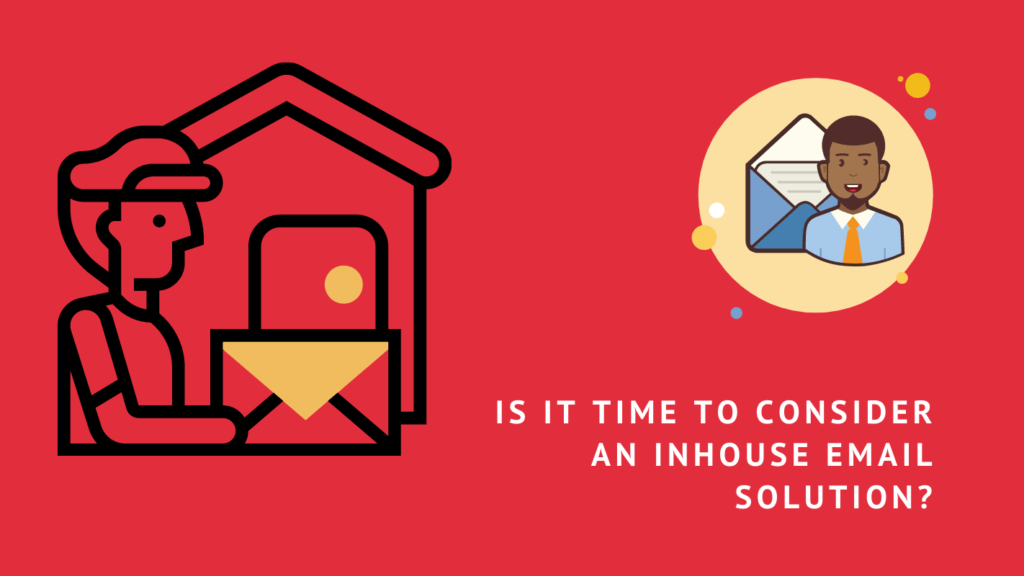The option for owning or at least controlling your own email infrastructure for your marketing efforts is increasingly viable looking at. In the early days of my career for a long period of time the vast majority of my consulting was spent designing, implementing, managing and supporting in-house email systems. However that was over twenty years ago now.
The good ol’ days of self hosted
There was a significant portion of my career where I spent my time assisting with email vendor selection, platform integrations and supporting organisations looking to make the most of their chosen SaaS Marcom platform.
What changed? Well at some point ESP’s got cheaper and more accessible. There was no need for a small business to manage complex operations in-house just because their marketing needs for email outstripped the functionality, features or service limitations of their person-to-person email vendor. The vast majority of companies had moved away from inhouse corporate mail systems to SaaS solutions like those provided by Microsoft and Google.
Here comes the SaaS wave
This was preceded by SalesForce and “The End of Software” marketing campaign in 2000. Sometime over the 10 years after that it became the default modus-operandi for business and then there were over 500 email service providers in the space offering SaaS solutions.
There were many ESP’s that rightly or wrongly would sell their services on heir superior deliverability. To discount the work that thousands of professionals put into professional delivery and deliverability would do my peers a serious disservice. To some extent I would argue compliance, delivery and deliverability teams still have the ability to massively influence the ability for your campaigns to be delivered where you want and when you want.
Not all teams are equal in that regard. Increasingly however ESP’s marketing message has matured alongside the audience and the channel.
We all grew up
Methods for authentication and monitoring and asserting email sender reputation have also matured and become increasingly complex. The net result, you are now told in unequivocal terms your reputation is your responsibility. Increasingly senders are being provisioned dedicated IP’s for better or worse, even with low email volumes. The impact of this is delivery is also in the hands of the sender in many respects, in terms of volumes, spikes and bursts. You will be advised to maintain consistent frequency and email volume.
I remember counselling large organisations that outsourcing to a SaaS based ESP meant the ability to divorce marketing from IT in terms of the email channel. Gone are the days where you did not have to make any changes to your dns and this would all be taken care of by your email marketing platform. For consistent delivery, to adhere to email authentication best practices and the like you will be required to configure some records on your DNS.
In a bid to simplify client onboarding, and to minimise the heavy lifting on the part of a client often times a vendor will suggest delegating one or more subdomains to their control. There are many organisations who cannot do this for operational reasons, security concerns or legal obligations.
The Cloud rolls in
A more recent but also significant shift we have seen over the past decade or so is a move from SaaS to The Cloud and virtual infrastructure. Anything you can do on bare-metal can be done if you spin up and configure the right instance at locations like Amazon AWS, Google Cloud Platform, Yandex.Cloud and others. Many business are increasingly doing this for their web based application needs. Whether it be for WordPress or Magento, or indeed for their custom applications built on Ruby or something else. The point is many organisations are increasingly technically sophisticated with teams in place to manage this.
Data, Security and Privacy Concerns
Take on board what some would describe as well founded concerns about data and data breaches (the industry has a fairly chequered history in respect of this) compounded by increasing legislation in terms of privacy and compliance. We recently saw Privacy Shield and Safe Harbor before that struck down and now business increasingly rely on ever more complex legal agreements in the hope they meet their obligations in terms of data transfer. These are not cheap nor light touch. Alternately you look to ESPs in Europe or your home territory that meets your legal obligations. Again this can come at a premium.
You will remember that when I started this post I said the majority of high volume senders I worked with where sending in-house, mostly from bare metal servers housed at a colocation facility or managed servers from a webhost. Those options still exists and in terms of an outbound mailserver bare metal actually often makes a lot of sense. There are the options now of cloud based solutions with fixed IPs and the ability to send email with perfectly reliable deliverability. In this respect I mean hosting your own PowerMTA, QMailer, PostFix or similar as your outbound mailserver. Although of course the aforementioned cloud based SMTP style solutions exist and there are many good arguments for using them, there really is nothing stopping you taking an IP from any number of ISPs and also having an MTA of your own.
The Hybrid System
When you consider an ESP they broadly fall into several categories. There are those that treat email on a commodity basis and charge a flat CPM rate (maybe extras for additional features) and there you have the likes of Amazon SES, Pepipost, Sparkpost, SendGrid and others. There has been a growth in the past ten years in this space too. With everything but the final mile being handled internally and just the delivery of the message passed off to the ESP for little more than delivery.
Whilst this was initially aimed at the developer community, those building their own SaaS solutions and online marketplaces they were equally suited to the self hosted solutions like Octeth OEMPro and others. In fact they spawned a whole new subset of self hosted solutions including the popular Sendy application. These provide an ESP like web based interface for managing your campaigns, tracking your stats and bounces and many of the functions you would expect inside your ESP.
In fact an entire eco system has grown up and matured in the past twenty years. There are a greater selection of commercial mailservers and more than functional open source solutions. In respect of the levels of SaaS based interface and integrations a mid level ESP would offer there are a wide variety of ‘self hosted’ email platforms now available, many of which are used by clients right through to the enterprise.
Writing this post I have realised I was inspired by a recent conversation I had with an old industry friend Cem Hurturk and a video he recently posted that covers in great detail much of what I touched in the the earlier section.
As you start to watch the video you will understand that it is neither rocket science nor is it simple or achievable for your average marketer or marketing team. Once setup you will want to monitor your delivery and deliverability and sender reputation and tweak for you or have you tweak your program to accommodate their findings. There is now a plethora of options available in this regard.
Deliverability Consultants, Services, Tools, Agencies…
When I started out I could probably count the number of people with ‘deliverability’ in their job title on the fingers of my hand(s). But there are now literally thousands of qualified individuals in the space. Dozens of qualified consultants that I could vouch for. There are business like Maillenium and Postmastery that have always had a focus on in-house and multi tenant senders ready and able to help you fine tune your outbound mailservers.
There are deliverability consultancies and despite the consolidation of email deliverability tools with Validity purchasing ReturnPath and 250ok, and SparkPost purchasing eDataSource there are still independent tools like MailMonitor and SendForensics, Litmus and EmailonAcid to help you with all aspects of your design and deliverability needs.
The ecosystem now covers almost every aspect and needs of a sender looking to send in-house from their own platform. There are even newer solutions like Taxi for Email and Chamaileon that help with workflow or design aspects of your email marketing now. The industry has matured and with deliverability and delivery pretty much your responsibility it may be time to at least consider owning the delivery of your email and the infrastructure that supports it.
With ever more complex systems in place for authentication many of the vendors that you would have had to look to for proper DMARC implementation are also happy to consult with and help deliver a fully compliant BIMI approved outbound mailstream for your marketing team. Think of companies like Dmarcian and others. There are even sophisticated SaaS based solutions that can help with your self hosted solutions, look to companies like Ongage.
The SaaS v Self Hosted Argument Rages On.
The longstanding arguments of SaaS vs Self hosted are still valid and the total cost of ownership still needs to be accounted for, as does business risk and reward. Will self hosted email platforms be the answer for everyone? No! That is beyond extremely unlikely.
If you are the type of organisation that is running all of your essential business operations as SaaS solutions with no tech-ops team and not managing multiple instances in the cloud or servers of your own as part of your daily operations then you can absolutely disregard any notion of running your own mailserver unless you will outsource the deployment and management. Again the options do now exist for even a fully managed self hosted email platform.
Wrapping Up
If you are an eommerce business or SaaS platform managing your own instances and/or servers and if you have a large product management team, you may find that the ESP your using is on the most part triggered via API calls or similar as a result of actions within your own application. That is to say the ESP you use, on the most part is just handling the last mile. You may even already be handling unsubscribes, bounces and other list management functions in-house. It may be that you are sending newsletters or other bulk type automated marketing from within another marketing automation platform.
Whilst that may well be the right thing to do, the opportunity to self host certainly exists, the ecosystem to support you in those efforts is stronger in 2020 than ever before and whilst it is not right for every business, I do feel a significant number of business are leaving much on the table by not at least considering their options in respects of self hosted.
In the spirit of my first series of blogs posts “Bonar calls BS” .. If anyone dismisses the idea of self hosted email completely out of hand, then I would be fairly quick to call BS.







